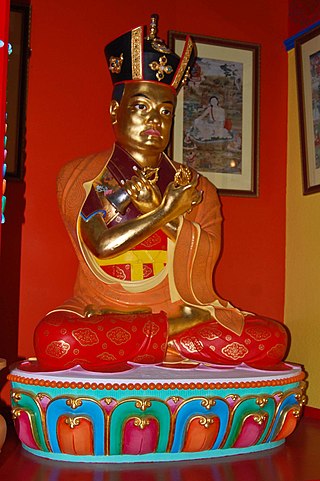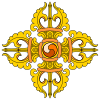
Dzogchen, also known as atiyoga, is a tradition of teachings in Indo-Tibetan Buddhism and Bon aimed at discovering and continuing in the ultimate ground of existence. The goal of Dzogchen is knowledge of this basis, this knowledge is called rigpa. There are spiritual practices taught in various Dzogchen systems for awakening rigpa.

Padmasambhava, also known as Guru Rinpoche and the Lotus from Oḍḍiyāna, was a tantric Buddhist Vajra master from medieval India who taught Vajrayana in Tibet. According to some early Tibetan sources like the Testament of Ba, he came to Tibet in the 8th century and helped construct Samye Monastery, the first Buddhist monastery in Tibet. However, little more is known about the actual historical figure other than his ties to Vajrayana and Indian Buddhism.

The Kagyu school, also transliterated as Kagyü, or Kagyud, which translates to "Oral Lineage" or "Whispered Transmission" school, is one of the main schools of Tibetan Buddhism. The Kagyu lineages trace themselves back to the 11th century Indian Mahasiddhas Naropa, Maitripa and the yogini Niguma, via their student Marpa Lotsawa (1012–1097), who brought their teachings to Tibet. Marpa's student Milarepa was also an influential poet and teacher.

Drikung Kagyü or Drigung Kagyü is one of the eight "minor" lineages of the Kagyu school of Tibetan Buddhism. "Major" here refers to those Kagyü lineages founded by the immediate disciples of Gampopa (1079-1153), while "minor" refers to all the lineages founded by disciples of Gampopa's main disciple, Phagmo Drupa (1110-1170). One of these disciples, Jigten Sumgön (1143-1217), is the founder of Drikung.

Nyingma, often referred to as Ngangyur, is the oldest of the four major schools of Tibetan Buddhism. The Nyingma school is founded on the first lineages and translations of Buddhist scriptures from Sanskrit into Tibetan in the eighth century, during the reign of King Trisong Detsen.

The Six Dharmas of Nāropa are a set of advanced Tibetan Buddhist tantric practices compiled by the Indian mahasiddhas Tilopa and Nāropa and passed on to the Tibetan translator-yogi Marpa Lotsawa.

The Shangpa Kagyu is known as the "secret lineage" of the Kagyu school of Vajrayana or Tibetan Buddhism and differs in origin from the better known Dagpo Kagyu schools. The Dagpo Kagyu are the lineage of Tilopa through his student Naropa, often traced through Naropa's famous student Marpa Lotsawa and thus called "Marpa Kagyu", while the Shangpa lineage descends from Tilopa's student Niguma, who was Naropa's sister, as well as from the teachings of Sukhasiddhi. Its founder was Khyungpo Naljor, the student of both women, whose monastery in the Shang Valley gave its name to the tradition.

Karma Kagyu, or Kamtsang Kagyu, is a widely practiced and probably the second-largest lineage within the Kagyu school, one of the four major schools of Tibetan Buddhism. The lineage has long-standing monasteries in Tibet, China, Russia, Mongolia, India, Nepal and Bhutan, with current centres in over 60 countries. The spiritual head of the Karma Kagyu is the Gyalwa Karmapa; the 2nd among the 10 Karmapas had been the principal spiritual advisors to successive emperors of China. The Karma Kagyu are sometimes called the "Black Hat" lamas, in reference to the Black Crown worn by the Karmapa.
In Tibetan Buddhism, Ngöndro refers to the preliminary, preparatory or foundational practices or disciplines common to all four schools of Tibetan Buddhism and also to Bon. They precede deity yoga.
Tertön is a term within Tibetan Buddhism meaning a person who is a discoverer of ancient hidden texts or terma. Many tertöns are considered to be incarnations of the twenty five main disciples of Padmasambhava, who foresaw a dark time in Tibet. He and his consort Yeshe Tsogyal hid teachings to be found in the future to benefit beings. A vast system of transmission lineages developed. Scriptures from the Nyingma school were updated by terma discoveries, and terma teachings have guided many Tibetan Bon and Buddhist practitioners.

Chagdud Tulku was a Tibetan teacher of the Nyingma school of Vajrayana Tibetan Buddhism. He was known and respected in the West for his teachings, his melodic chanting voice, his artistry as a sculptor and painter, and his skill as a physician. He acted as a spiritual guide for thousands of students worldwide. He was the sixteenth tülku of the Chagdud line.

Kyabje Dudjom Rinpoche Jigdral Yeshe Dorje was known simply as Dudjom Rinpoche. He is considered by many Tibetan Buddhists to be from an important Tulku lineage of Terton Dudul Dorje (1615-1672), and was recognized as the incarnation of Terton Dudjom Lingpa (1835-1904), a renowned treasure revealer. He was a direct incarnation of both Padmasambhava and Dudjom Lingpa. He was a Nyingma householder, a yogi, and a Vajrayana and Dzogchen master. According to his secretary Khenpo Tsewang Dongyal and many others, he was revered as "His Holiness" (Kyabje) and as a "Master of Masters".
Anuyoga is the designation of the second of the three Inner Tantras according to the ninefold division of practice used by the Nyingma school of Tibetan Buddhism. This schema categorizes various stages of practice, and Anuyoga specifically emphasizes the completion stage of Tantra. As with the other yanas, Anuyoga represents both a scriptural division as well as a specific emphasis of both view and practice. Anuyoga delves into inner practices involving the subtle body, chakras, prana, nadis, and consciousness (bindu). It is particularly suited for individuals whose primary obstacle is passion and is associated with the feminine principle.

Longchen Nyingthig is a terma, revealed scripture, of the Nyingma school of Tibetan Buddhism, which gives a systematic explanation of Dzogchen. It was revealed by Jigme Lingpa (1730–1798).
In Dzogchen, rainbow body (Tibetan: འཇའ་ལུས་, Wylie: 'ja' lus, Jalü or Jalus) is a level of realization. This may or may not be accompanied by the 'rainbow body phenomenon'. The rainbow body phenomenon is pre-Buddhist in origin, and is a topic which has been treated fairly seriously in Tibet for centuries past and into the modern era. Other Vajrayana teachings also mention rainbow body phenomena which occur during or after the dying process.
In Tibetan Buddhism and Bön, Zhitro or Shitrozab-chos zhi khro dgongs pa rang grol, also known as kar-gling zhi-khro refers to a cycle of teachings revealed by the terton Karma Lingpa and traditionally believed to have been written by Padmasambhava. The practices involve a mandala of 100 peaceful (zhi) and wrathful (khro) tantric deities and associated teachings and tantric practices which focus on those deities which represent the purified elements of the body and mind. These hundred peaceful and wrathful deities are believed to manifest to a deceased person following the dissolution of the body and consciousness whilst they are in the intermediate state, or bardo, between death and rebirth. The Bardo Thodol, commonly known in the West as "The Tibetan Book of the Dead", forms one section of Karma Lingpa's Zhitro cycle. The Zhitro teachings are closely related to the Guhyagarbha Tantra and are considered an Inner Tantra.

Dudjom Lingpa (1835–1904) was a Tibetan Nyingma school meditation master, spiritual teacher and tertön. He was a recognized reincarnation of Rigdzen Düddul Dorje, and therefore of Khye'u Chung Lotsawa who was among the twenty-five heart students of Guru Padmasambhava. Raised in Amdo, Tibet, he had no formal education, nor did he take ordination as a monk or belong to an established Buddhist monastery. Instead, he received direct teachings through visionary experiences with the Nyingma school masters Padmasambhava and Yeshe Tsogyal, and with other Buddhas and realized beings. His subsequent reincarnation is the highly revered Kyabje Dudjom Rinpoche.

Ayang Tulku Rinpoche is a Tibetan Buddhist lama.

Dzogchen practice refers to the various contemplative practices which are part of the Tibetan Buddhist traditions of Dzogchen. Dzogchen contemplation or meditation relies on having the proper Dzogchen view, which, according to Tibetan Dzogchen teacher Namkhai Norbu, is not an intellectual view, but a "direct, non-dual, non-conceptual knowledge" of fundamentally pure absolute nature which has become veiled by dualistic conditioning. In Dzogchen, one achieves this view through one's relationship with a guru or lama who introduces one to our own primordial state and provides instruction on how to practice. This "direct introduction" and transmission from a Dzogchen master is considered absolutely essential.

The mind teachings of Tibet are a body of sacredly held instructions on the nature of mind and the practice of meditation on, or in accordance with, that nature. Although maintained and cultivated, to various degrees, within each of the major Tibetan Buddhist traditions, they are primarily associated with the mahamudra traditions of the Kagyu and the dzogchen traditions of the Nyingma.
















